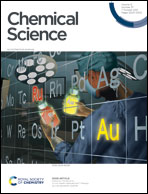Tuning of bandgaps and emission properties of light-emitting diode materials through homogeneous alloying in molecular crystals†
Abstract
Alloy formation is ubiquitous in inorganic materials science, and it strongly depends on the similarity between the alloyed atoms. Since molecules have widely different shapes, sizes and bonding properties, it is highly challenging to make alloyed molecular crystals. Here we report the generation of homogenous molecular alloys of organic light emitting diode materials that leads to tuning in their bandgaps and fluorescence emission. Tris(8-hydroxyquinolinato)aluminium (Alq3) and its Ga, In and Cr analogues (Gaq3, Inq3, and Crq3) form homogeneous mixed crystal phases thereby resulting in binary, ternary and even quaternary molecular alloys. The MxM′(1−x)q3 alloy crystals are investigated using X-ray diffraction, energy dispersive X-ray spectroscopy and Raman spectroscopy on single crystal samples, and photoluminescence properties are measured on the exact same single crystal specimens. The different series of alloys exhibit distinct trends in their optical bandgaps compared with their parent crystals. In the AlxGa(1−x)q3 alloys the emission wavelengths lie in between those of the parent crystals, while the AlxIn(1−x)q3 and GaxIn(1−x)q3 alloys have red shifts. Intriguingly, efficient fluorescence quenching is observed for the MxCr(1−x)q3 alloys (M = Al, Ga) revealing the effect of paramagnetic molecular doping, and corroborating the molecular scale phase homogeneity.



 Please wait while we load your content...
Please wait while we load your content...